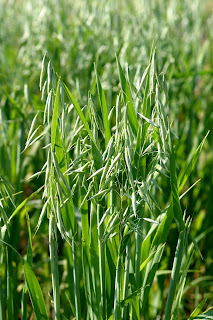Our bread and cereal comes from GRASSES! As my Hortus Third A Concise Dictionary of Plants Cultivated in the United States and Canada states about grasses: One of the largest families, the most important economically and the most widely distributed worldwide. The four big cereal grasses are currently nearing maturity in the Old Missouri -- Row Crops Quilt of the Heartland Harvest Garden.

Barley in the foreground and Rye in the background form the eastern 2 sides of the Old Missouri Quilt.

Our Barley is 'Two Row Barley' (Hordeum vulgare), most widely grown for malt while 'Six Row Barley' is higher in protein and mainly used for food.

Cereal Rye (Secale cereale) is an important cereal and fodder crop.

The western flanks of the Old Missouri Quilt are bound by rows of oats in the foreground and winter wheat beyond (closest to the Quilt Arbors).

Our Oats on display are 'Hull-less Oats' (Avena sativa), the source of the Cheerios that grace your bowl at breakfast .

Winter Wheat (Triticum aestivum) is the common bread wheat. Your whole wheat bread begins here with the seed grains of this plant.

And what would your morning cereal be without fresh blueberries? Our northern or Minnesota series varieties are starting to ripen and should be available for tasting this weekend. This is 'Northblue' Blueberry, a hybrid between northern wild "lowbush" (Vaccinium angustifolium) and regular "highbush" blueberries (Vaccinium corymbosum).
The cereal grains should be harvested by the Fourth of July and the blueberries should be producing from now until August. We still have strawberries ripening so look for those at tasting stations as well. A plethora of companion plants is also in bloom from marvelous blue Hyssop (Hyssopus officinalis) in the Vineyard to vivacious Bergamots & Beebalms (Monarda) along the Pear Promenade. The vegetables of summer are gradually replacing the spring crops. Come see the Heartland Harvest Garden and its continual changes: you will be amazed!

No comments:
Post a Comment